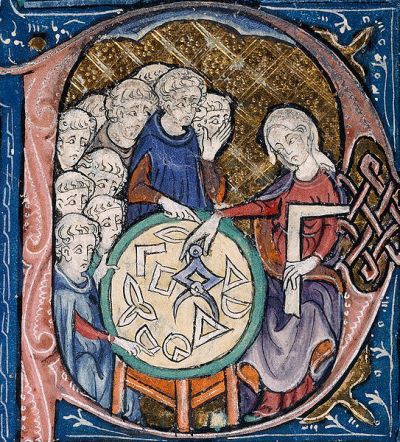The acronym STEM was established by the National Science Foundation in 2001 – rearranged from SMET – to represent Science, Technology, Engineering, and Math. A STEM education focuses on integrating these subjects into a wider curriculum to better educate students for a diverse workforce. Education is a key element for success, but it comes in many forms, depending upon the particular circumstances of those being taught.
During the Middle Ages, education for women was rare. One option was to enter a convent, where nuns were taught lessons of the bible, along with other topics. Noble women were tutored in various subjects, but they were still expected to marry and have children, as were common women with their training centered on domestic duties.
For most births, a midwife was present and many women took on this role. Sometime during the 12th century, Trota of Salerno emerged as a trusted medical advisor and physician for women. She was associated with Schola Medica Salernitana, established in the eighth century as part of a monastery, but later sanctioned as secular. Currently, although she has been given nobility, a family and other attributes, no records are available to chronicle Trota’s life before she became known as a women’s doctor specializing in gynecology. However, her experiences transcended men’s knowledge of women’s medical needs and she combined that experience with the cultural, philosophical and practical concepts in healing, gaining an education in the sciences and technologies of the time.
During the 18th century, education for women was available, but mostly limited to those in wealthy families or with a financial supporter. Social status was also a factor, as knowing influential people widen a woman’s opportunities for acceptance.
Laura Maria Caterina Bassi was tutored at home, learning French, Latin and mathematics. Her father was an affluent lawyer, but she gained the attention of the noted doctor who often visited Laura’s home to attend to her ill mother. He was also a philosophy professor at the University of Bologna and a member of the Academy of Sciences of Bologna and was so impressed with Laura’s knowledge of science, he expanded her education to include natural philosophy, metaphysics, logic, physics, and Newton’s “Opticks” (experiments with white and colored light).
In 1732 with her specialized education, Bassi defended 49 Thesis in a public event and earned a Doctor of Philosophy from the University. She was the first woman elected to the Academy of Sciences of Bologna. Because she was a woman, she was not permitted to teach at the University so she taught in her home, studied advanced mathematics and continued her studies in science. She married a fellow scientist and they worked together – most notably in Newtonian physics. Two years before she died, Bassi was appointed a University Chair of Experimental Physics and was allowed to teach classes at the University. She was a leading figure in the scientific field, paving the way for woman in science and math to be recognized for their work.
Proficient in seven languages before her 12th birthday and in mathematics and philosophy by her late teens, Maria Gaetana Agnesi was privately tutored. As the oldest of 21 children, she relented to the wishes of her wealthy father and stayed home to tutor her younger brothers. To assist in their education, she wrote a mathematics textbook – considered the first by a woman – explaining the theories in clearer terms. The Witch of Agnesi is a mathematical curve erroneously named after her.
In the early 20th century, most women were still expected to follow the traditional role of wife and mother and Rita Levi-Montalcini was no exception. Yet, she resisted her father’s wishes and convinced him to accept her choice of attending the medical program at the University of Turin. There, she worked with a top histologist and professor of anatomy in experimenting with the development of cells in the nervous system. She faced obstacles as a woman and as a Jewish professional, twice escaping from the Germans during WWII and twice establishing laboratories in her home. Her collaboration with a fellow researcher expanded on the importance of Nerve Growth Factor and led to a shared Nobel Prize in Physiology or Medicine in 1986. Rita Levi-Montalcini received numerous awards and honors including an appointment to Italian Senator for Life. She was an early-20th century woman of a STEM education, benefiting medical research and the world with her scientific findings.
For the biographies and selected resources of these and other exceptional women of Italian heritage, visit the website of the Italian Historical Society of America at www.italianhistorical.org/index.html.



